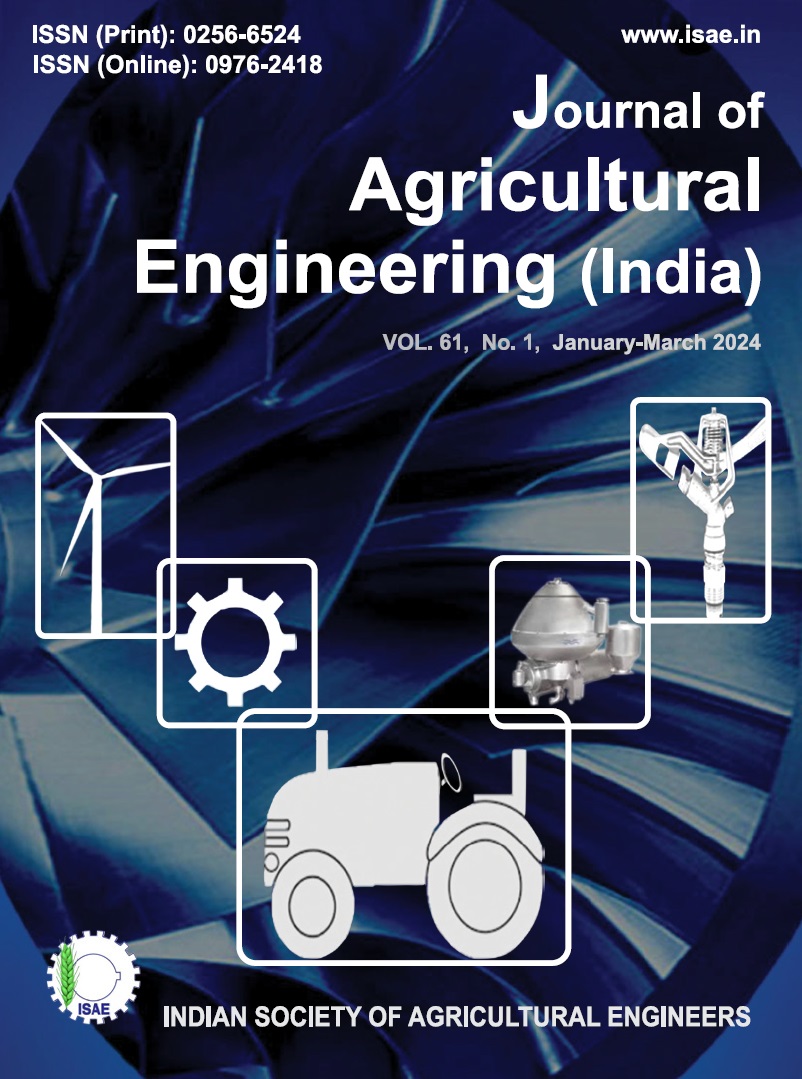Inclined Tubes Clarifier for Effective Removal of Suspended Solids from Canal Water Prior to Groundwater Recharge
DOI:
https://doi.org/10.52151/jae2024611.1831Keywords:
Canal water, groundwater recharge, inclined tubes clarifier, total suspended solids, sludgeAbstract
Groundwater recharge, through surplus supplies of canal water, may prove to be an important strategy for replenishing the rapidly depleting groundwater in Punjab and managing sustainably the groundwater resources. However, presence of suspended silt load in the canal water results in clogging of recharge wells and subsequent reduction in recharge rates and capacity of filters. In present study, an inclined tubes clarifier having filtration capacity of 1.8 L s-1 was designed and fabricated to filter the silt-loaded canal water. In the clarifier, tubes of poly vinyl chloride (PVC) media of 1-m length were attached one over the other to form an inclined honeycomb like structure through which canal water enters as inflow from the bottom and the clarified water exits as outflow from the top of the clarifier. Efficacy of the designed clarifier was tested at different total suspended solids ranging from 500 to 3000 mg L-1 in the canal water and at pumping rates varying from 0.3 to 2.1 L s-1. The results revealed more than 85% sediment-removal efficiency of the clarifier at flow rates above 0.8 L s-1. The results further indicated that efficiency of removing total suspended solids (TSS) reduced drastically at inflow rates more than 1.2 L s-1. Also, at all the flow rates, the efficiency was 6% higher for water samples having TSS more than 2000 mg L-1 in comparison to samples having TSS less than 1000 mg L-1. The clarifier makes no significant difference to the values of total dissolved solids, electrical conductivity, total solids and pH of the canal water.
References
Anonymous (2012) https://www.worldbank.org/en/news/feature/2012/03/06/india-groundwater-critical-diminishing
Anonymous (2017) Report of the groundwater resource estimation committee. (GEC-2015). Ministry of Water Resources, River Development & Ganga Rejuvenation Government of India http://cgwb.gov.in/Documents/GEC2015_Report_Final%2030.10.2017.pdf
Baweja S, Aggarwal R and Brar M (2018) Groundwater Depletion in Punjab, India. Ency Soil Sci 3:1-2.
Gupta A (2018) Mathematical formulation of groundwater recharge through abandoned well. M.Tech thesis, Punjab Agricultural University, Ludhiana, India.
Hernandez and Wright (1970) Sedimentation Process and Design of Settling Systems. Springer Transactions in Civil and Environmental Engineering. Pp 287-97.
Johnson, Ratnayaka, Don D, Brandt, Malcolm J and Michael (2009). Twort's water supply, Oxford: Butterworth-Heinemann. ISBN 978-0-0809-4084-7.
Kucera and Jane (2011) Reverse Osmosis: Design Processes and Applications for Engineers. John Wiley & Sons. ISBN 978-1-1182-1144-1.
Martin R (2013) Clogging Issues Associated with Managed Aquifer Recharge Methods. IAH Commission on Managed Aquifer Recharge: Adelaide, Australia.
McKean (2010). Novel application of a lamella clarifier for improved primary treatment of domestic wastewater (PDF).73rd Annual Water Industry Engineers and Operators’ Conference.
Michael A (2008) Irrigation theory and practice second edition Pp.291. Vikas publishing house pvt ltd, New Delhi.
Patel P, Shah T and Saha D (2020) Sustainability of groundwater through community-driven distributed recharge: An analysis of arguments for water scarce regions of semi-arid India. Vol 29. J Hydro: Regional Studies:Pp 100680.
Sarkar S, Kamilya D and Mal B (2007). Effect of geometric and process variables on the performance of inclined plate settlers in treating aquacultural waste. Water res 41: 993-1000.
Wang K, Hung Y and Shammas N (2005) Physico-chemical treatment processes. Humana Press, New Jersey, US. Pp391-407.
Liu, L., Perez, M. A., & Whitman, J. B. (2020). Evaluation of Lamella Settlers for Treating Suspended Sediment. Water, 12(10), 2705. MDPI AG. Retrieved from http://dx.doi.org/10.3390/w12102705
Fuchs, S., Mayer, I., Haller, B., & Roth, H. (2014). Lamella settlers for storm water treatment–performance and design recommendations. Water science and technology, 69(2), 278-285.
Al-Dulaimi,S. & Racoviteanu,G.(2018).Performance of the Tube Settler Clarification at Different Inclination Angles and Variable Flow Rate. Modelling in Civil Environmental Engineering,14(2) 13-25. https://doi.org/10.2478/mmce-2018-0004.
Fujisaki, K., & Terashi, M. (2005). Improvement of settling tank performance using inclined tube settlers. WIT Transactions on Ecology and the Environment, 80.
Clark, S. E., Elligson, J. C., Mikula, J. B., Roenning, C. D., Siu, C. Y., & Hafera, J. M. (2007). Inclined plate settlers to treat stormwater solids. In World Environmental and Water Resources Congress 2007: Restoring Our Natural Habitat (pp. 1-12).














